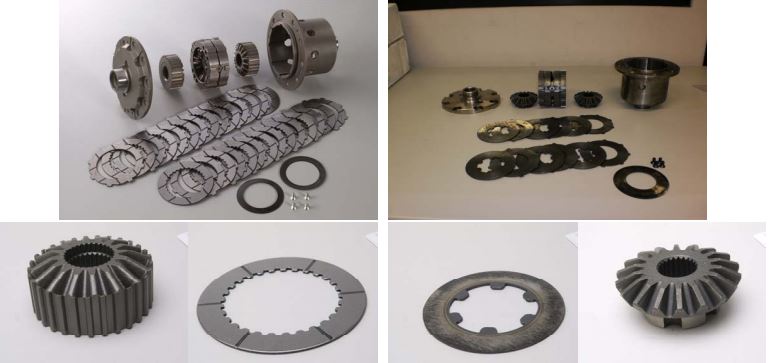DESIGN DIFFERENCES
“TRADITIONAL” Clutch-type L.S.D. (competitors versions)
– typically use cast components, no heat treatment
– larger pressure ring limits space for disks
– less rigid side gears
– less plate capacity
– no progressive locking ability
– less surface area on disks
– disks are typically manufactured with a larger manufacturing variance
– no relief on the case for cone springs

OS Superlock differential lock
Uses raw-forged gears, chemical heat treatment on all components, high-grade steel alloy. Miniaturized pressure ring allows for a higher disk capacity. Spline-through-side-gear design also allows for a higher disk capacity as well as additional side gear strength. Patented pressure ring design allows for progressive, tunable locking. Relief cut into the case minimizes stress on the cone spring during LSD operation. Friction disks are precision-machined on both sides simultaneously to extremely tight tolerances (there are only 2 machines in Japan that have this capability)

OS SUPERLOCK L.S.D.
No break-in procedure required: OS LSD is precision-machined to very high tolerances; once it is installed it can immediately be used for race. No overhaul required: OS LSD has true 100% lock capability and is constructed with high-grade materials using superior manufacturing methods for extreme durability. Ultra-consistent performance: The design and manufacturing of OS LSD does not allow for significant wear on the components, which promotes consistent performance regardless of the amount of use. Many teams have been using the same OS LSD for over 10 years with no need for service other than normal maintenance (periodic fluid changes). Fluid changes at normal factory intervals: OS recommends the first fluid change after 1 event or 500-1000miles in order to flush out debris left over from the manufacturing process. Subsequent changes are recommended at the normal factory-recommended intervals. Quiet/composed for normal street driving: Since OS LSD offers smooth, progressive locking up to 100% with a low amount of preload, it will feel like an open diff at slow speeds, but will still efficiently transfer power to the ground under load.

PERFORMANCE DIFFERENCES
Break-in procedure required: usually consists of doing figure-8s in an empty lot for 30 minutes. Since 100% lock capability is not possible, the friction created by the plates generates high levels of heat, which essentially wear down the plates so that they can seat to each other properly. (Lower manufacturing tolerances for the plates result in variances in shape, thickness, etc.) This type of break-in procedure may lead to uneven wear between the left and right side of the LSD.

Periodic overhaul required: Since these types of LSD cannot achieve true 100% locking, constant friction on the LSD components generates more heat which leads to additional wear or premature failure, necessitating periodic overhaul of LSD components.
Inconsistent performance: Since these LSD’s already have driver-induced wear from break-in and continue to wear throughout the lifespan of the unit, actual locking performance diminishes the more the unit is used. More frequent fluid changes required: Due to the amount to friction created in the
LSD, additional heat is generated which leads to earlier break-down of the diff
fluid. Fluid changes are usually recommended every 5000-8000 miles for normal usage.

Inconvenient for normal street driving: These types of LSD can only operate
within a certain range of lock capacity (e.g. 60% accel, 40% decel) and can be adjusted by increasing/decreasing the preload. Typically, preload is set on the higher side in order to achieve more lock capability, but comes at the cost of the unit locking at slower speeds. Normal behavior is for the wheels to “skip” through turns and to generate undesireable noise.
